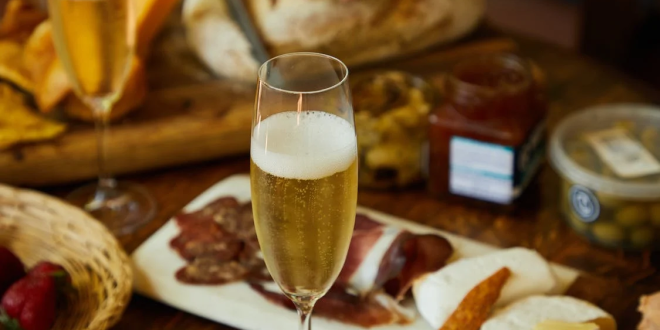You’ve got music and food but the party doesn’t come alive until you’ve thought about the sparkling wine. For the uninitiated, the world of bubbly can be as intimidating as it is exciting. With different names, regions, and customs, it’s easy to feel a little lost in the fizzy fray. But fear not, newbie oenophiles, for we’re about to pop the cork on the grand mystery of sparkling wine, breaking down the bubbles with a sprinkle of humour and clarity.
Champagne: The Classic Overachiever
Champagne is the first name that came to mind when reading the article title (be honest!). It’s the alumnus from the School of Hard Knocks; the devotee of time, tradition, and technique. Its prestigious roots are deep in the chalky soils of France, where the noble varietals of Chardonnay, Pinot Noir, and Pinot Meunier reign.
Some people save this one for the special occasions while others like to have it on the regular. Do you celebrate promotions or getting to the end of Monday? Champagne is the sparkling wine that holds itself to the highest sparkling standard. Expect tiny, persistent bubbles that seem to dance in the glass and a crisp, ranged flavour that can range from bone-dry (Brut Nature) to quite sweet (Doux).
Prosecco: The Lighthearted Comrade
Prosecco is the friend that sings “Don’t Stop Believin'” at the top of their lungs in the car. Unlike the more austere Champagne, Prosecco exudes an approachable, casual fun. Hailing from the hills of Veneto in northeastern Italy, Prosecco is typically produced using the Glera grape, offering softer and more floral aromatics. It’s often a bit less bubbly than its French cousin, with larger, frothier bubbles.
Prosecco is also crafted using a different winemaking process than Champagne, called the Charmat method, which creates its signature effervescence. It’s the bottle many reach for when hosting brunch, preparing a spritz, or when they want to add a little lift to the day without breaking the bank.
Cava: The Spirited Spanish Dancer
Picture a bullfighter in a glass, and you have Cava sparkling wine. Originating from the Catalan heartlands, Cava is Spain’s answer to the celebratory fizz, sharing more with Champagne than just a sparkling quality. Made using the same traditional method of winemaking, Cavas can often offer a similar level of complexity, albeit with a distinctively Spanish flare.
With grapes such as Macabeo, Parellada, and Xarel-lo, it carries a character that’s both tangy and taut, perfect for sipping between bites of paella or toasting to a Flamenco performance.
Rosé and Shiraz Sparkling: The Colour Curves
Sometimes, you want a little vibrancy in your bubbles. For those moments, there’s sparkling rosé and sparkling Shiraz. Pink, yet not entirely demure, sparkling rosés can be derived from a variety of grapes but showcase a hue that captures and refracts the light just so.
Meanwhile, sparkling Shiraz from Down Under adds a level of sun-soaked fruit and boldness that’s unmistakably Australian. It’s the sparkling that’s as at home at a beachside barbecue as it is a black-tie event.
Now, tasting notes scribbled, glasses charged, it’s time for beginners to become explorers. Adventure awaits in every bottle, and diversity is the spice of the sparkling wine life. Remember, there’s no wrong way to enjoy these diverse drops, so savour your learning experience and, above all, raise your glass to a bountiful bubbly future!
 Isaiminia World Breaking News & Top Stories
Isaiminia World Breaking News & Top Stories




